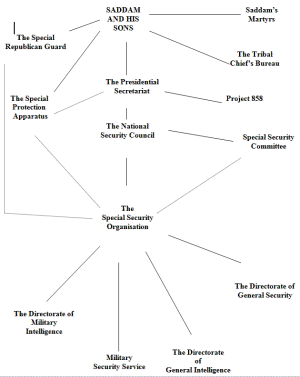By Michael Rivero
The Downing Street Memo is only the beginning of the proof we were all lied to.
NOTICE: THIS WORK MAY BE PROTECTED BY COPYRIGHT
YOU ARE REQUIRED TO READ THE COPYRIGHT NOTICE AT THIS LINK BEFORE YOU READ THE FOLLOWING WORK, THAT IS AVAILABLE SOLELY FOR PRIVATE STUDY, SCHOLARSHIP OR RESEARCH PURSUANT TO 17 U.S.C. SECTION 107 AND 108. IN THE EVENT THAT THE LIBRARY DETERMINES THAT UNLAWFUL COPYING OF THIS WORK HAS OCCURRED, THE LIBRARY HAS THE RIGHT TO BLOCK THE I.P. ADDRESS AT WHICH THE UNLAWFUL COPYING APPEARED TO HAVE OCCURRED. THANK YOU FOR RESPECTING THE RIGHTS OF COPYRIGHT OWNERS.
"All war is based on deception." -- Sun Tzu, The Art of War
There is nothing new in a government lying to their people to start a war. Indeed because most people prefer living in peace to bloody and horrific death in war, any government that desires to initiate a war usually lies to their people to create the illusion that support for the war is the only possible choice they can make.
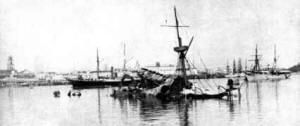
President McKinley told the American people that the USS Maine had been sunk in Havana Harbor by a Spanish mine. The American people, outraged by this apparent unprovoked attack, supported the Spanish American War. The Captain of the USS Maine had insisted the ship was sunk by a coal bin explosion, investigations after the war proved that such had indeed been the case. There had been no mine.
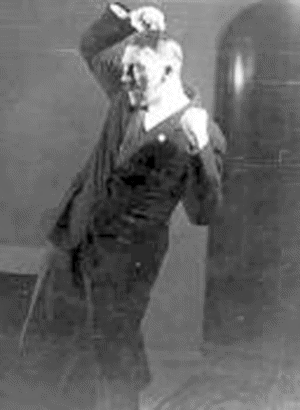
Hitler used this principle of lying to his own people to initiate an invasion. He told the people of Germany that Poland had attacked first and staged fake attacks against German targets. The Germans, convinced they were being threatened, followed Hitler into Poland and into World War 2.
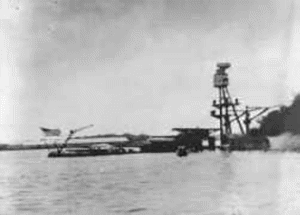
FDR claimed Pearl Harbor was a surprise attack. It wasn't. The United States saw war with Japan as the means to get into war with Germany, which Americans opposed. So Roosevelt needed Japan to appear to strike first. Following an 8-step plan devised by the Office of Naval Intelligence, Roosevelt intentionally provoked Japan into the attack. Contrary to the official story, the fleet did not maintain radio silence, but sent messages intercepted and decoded by US intercept stations. Tricked by the lie of a surprise attack, Americans marched off to war.
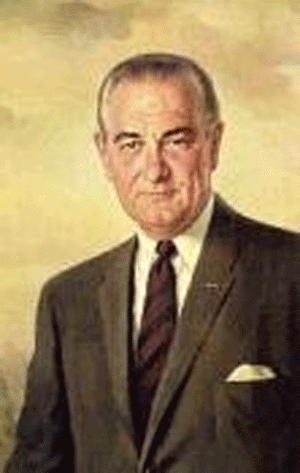
President Johnson lied about the Gulf of Tonkin to send Americans off to fight in Vietnam.
There were no torpedoes in the water in the Gulf. LBJ took advantage of an inexperienced sonar man's report to goad Congress into escalating the Vietnam War.
It is inescapable historical reality that leaders of nations will lie to their people to trick them into wars they otherwise would have refused. It is not "conspiracy theory" to suggest that leaders of nations lie to trick their people into wars. It is undeniable fact.
This brings us to the present case.
Did the government of the United States lie to the American people, more to the point, did President Bush and his Neocon associates lie to Congress, to initiate a war of conquest in Iraq?
This question has been given currency by a memo leaked from inside the British Government which clearly indicates a decision to go to war followed by the "fixing" of information around that policy. This is, as they say, a smoking gun.
But the fact is that long before this memo surfaced, it had become obvious that the US Government, aided by that of Great Britain, was lying to create the public support for a war in Iraq.
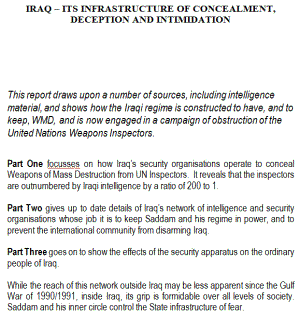
First off is Tony Blair's "Dodgy Dossier", a document released by the Prime Minister that made many of the claims used to support the push for war. The dossier soon collapsed when it was revealed that much of it had been plagiarized from a student thesis paper that was 12 years old!
The contents of the dossier, however much they seemed to create a good case for invasion, were obsolete and outdated.
This use of material that could not possibly be relevant at the time is clear proof of a deliberate attempt to deceive.
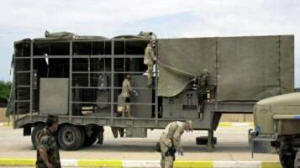
Then there was the claim about the "Mobile biological weapons laboratories". Proffered in the absence of any real laboratories in the wake of the invasion, photos of these trailers were shown on all the US Mainstream Media, with the claim they while seeming to lack anything suggesting biological processing, these were part of a much larger assembly of multiple trailers that churned out biological weapons of mass destruction.
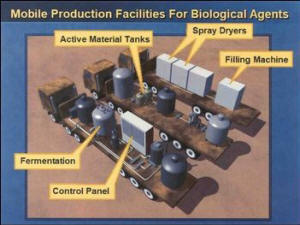
The chief proponent of this hoax was Colin Powell, who presented illustrations such as this one to the United Nations on February 5th, 2003.
This claim fell apart when it was revealed that these trailers were nothing more than hydrogen gas generators used to inflate weather balloons. This fact was already known to both the US and UK, as a British company manufactured the units and sold them to Iraq.
Colin Powell's speech to the UN was itself one misstatement after another. Powell claimed that Iraq had purchased special aluminum tubes whose only possible use was in uranium enrichment centrifuges. Both CIA and Powell's own State Department confirmed that the tubes were parts for missiles Saddam was legally allowed to have. Following the invasion, no centrifuges, aluminum or otherwise were found.
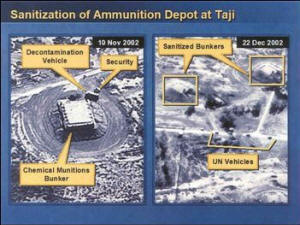
Powell also claimed to the United Nations that the photo on the left showed "Decontamination Vehicles". But when United Nations inspectors visited the site after the invasion, they located the vehicles and discovered they were just firefighting equipment.
Powell claimed the Iraqis had illegal rockets and launchers hidden in the palm trees of Western Iraq. None were ever found.
Powell claimed that the Iraqis had 8,500 liters (2245 gallons) of Anthrax. None was ever found.
Powell claimed that Iraq had four tons of VX nerve gas. The UN had already confirmed that it was destroyed. The only VX ever found were samples the US had left as "standards" for testing. When the UN suspected that the US samples had been used to contaminate Iraqi warheads, the US moved quickly to destroy the samples before comparison tests could be carried out.
Powell claimed that Iraq was building long-range remote drones specifically designed to carry biological weapons. The only drones found were short-range reconnaissance drones.
Powell claimed that Iraq had an aggregate of between 100 and 500 tons of chemical and biological warfare agents. Powell gave no basis for that claim at all, and a DIA report issued the same time directly contradicted the claim. No biological or chemical weapons were found in Iraq following the invasion.
Powell claimed that "unnamed sources" confirmed that Saddam had authorized his field commanders to use biological weapons. No such weapons were ever used by the Iraqis to defend against the invasion and, of course, none were ever found in Iraq.
Powell claimed that 122mm warheads found by the UN inspectors were chemical weapons. The warheads were empty, and showed no signs of ever having contained chemical weapons.
Powell claimed that Iraq had a secret force of illegal long-range Scud missiles. None were ever found.
Powell claimed to have an audio tape proving that Saddam was supporting Osama Bin Laden. But independent translation of the tape revealed Osama's wish for Saddam's death.
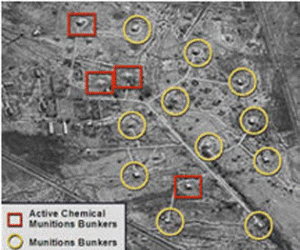
Colin Powell's UN debacle also included spy photos taken from high flying aircraft and spacecraft. On the photos were circles and arrows and labels pointing to various fuzzy white blobs and identifying them as laboratories and storage areas for Saddam's massive weapons of mass destruction program. Nothing in the photos actually suggested what the blobby shapes were and during inspections which followed the invasion, all of them turned out to be rather benign.
In at least one case, the satellite Powell claimed had taken one of the pictures had actually been out of operation at the time. And many questioned why Powell was showing black and white photos when the satellites in use at the time over Iraq took color images.
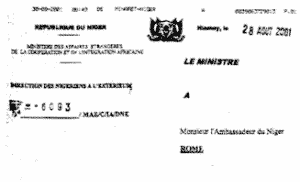
Another piece of evidence consists of documents which President Bush referenced as in his 2003 State of the Union Speech. According to Bush, these documents proved that Iraq was buying tons of uranium oxide, called "Yellow Cake" from Niger.
Since Israel had bombed Iraq's nuclear power plant years before, it was claimed that the only reason Saddam would have for buying uranium oxide was to build bombs.
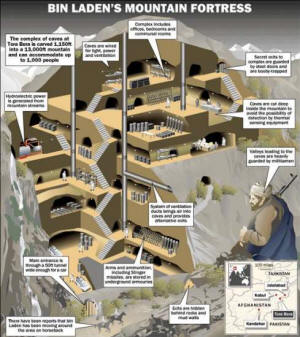
Osama bin Laden's "Mountain Fortress", shown to the US public by the corporate media, and like Saddam's nuclear weapons, never actually existed.
This hoax fell apart fast when it was pointed out that Iraq has a great deal of uranium ore inside their own borders and no need to import any from Niger or anywhere else. The I.A.E.A. then blew the cover off the fraud by announcing that the documents Bush had used were not only forgeries, but too obvious to believe that anyone in the Bush administration did not know they were forgeries! The forged documents were reported as being "discovered" in Italy by SISMI, the Italian Security Service. Shortly before the "discovery" the head of SISMI had been paid a visit by Michael Ledeen, Manucher Ghorbanifar, and two officials from OSP, one of whom was Larry Franklin, the Israeli spy operating inside the OSP.
In July, 2005, the Italian Parliament concluded their own investigation and named four men as suspects in the creation of the forged documents. Michael Ledeen, Dewey Clarridge, Ahmed Chalabi and Francis Brookes. This report has been included in Patrick Fitzgerald's investigation into the outing of Valerie Plame, and Paul McNulty, the prosecutor of the AIPAC spy case.
A recently declassified memo proves that the State Department reported the fact that the NIger documents were forgeries to the CIA 11 days before President Bush made the claim about the Niger uranium based on those documents.
In the end, the real proof that we were lied to about Iraq's weapons of mass destruction is that no weapons of mass destruction were ever found. That means that every single piece of paper that purported to prove that Iraq had weapons of mass destruction was by default a fraud, a hoax, and a lie. There could be no evidence that supported the claim that Iraq had weapons of mass destruction because Iraq did not have weapons of mass destruction. In a way, the existence of any faked documents about Iraq's WMDs is actually an admission of guilt. If one is taking the time to create fake documents, the implication is that the faker is already aware that there are no genuine documents.
What the US Government had, ALL that they had, were copied student papers, forged "Yellow Cake" documents, balloon inflators posing as bioweapons labs, and photos with misleading labels on them. And somewhere along the line, someone decided to put those misleading labels on those photos, to pretend that balloon inflators are portable bioweapons labs, and to pass off stolen student papers as contemporary analysis.
And THAT shows an intention to deceive.
Lawyers call this "Mens Rea", which means "Guilty Mind". TV lawyer shows call it "Malice aforethought". This means that not only did the Bush Administration lie to the people and to the US Congress, but knew they were doing something illegal at the time that they did it.
All the talk about "Intelligence failure" is just another lie. There was no failure. Indeed the Army agents who erroneously claimed that missile tubes were parts for a uranium centrifuge received bonuses, while the Pentagon smeared Hans Blix, and John Bolton orchestrated the firing of Jose Bustani, the director of the Organization for the Prohibition of Chemical Weapons, because Bustani was trying to send chemical weapons inspectors to Baghdad.
The President of the United States and his Neocon associates lied to the people of the United States to send them off on a war of conquest.
Defenders of the government will point to the cases listed at the top of the page as proof that lying to the people is a normal part of the leader's job and we should all get used to it. And because "Everybody does it" that we should not single out the present administration. But this is madness. We do not catch all the murderers, yet when we catch a murderer, we deal with them as harshly as possible, in order to deter more murderers.
Right now, we have the criminals at hand. and, while other leaders in history have lied to start wars, for the first time in history, the lie stands exposed while the war started with the lies still rages on, to the death and detriment of our young men and women in uniform. We cannot in good moral conscience ignore this lie, this crime, lest we encourage future leaders to continue to lie to us to send our kids off to pointless wars. Lying to start a war is more than an impeachable offence; it the highest possible crime a government can commit against their own people. Lying to start a war is not only misappropriation of the nation's military and the nation's money under false pretenses, but it is outright murder committed on a massive scale. Lying to start a war is a betrayal of the trust each and every person who serves in the military places in their civilian leadership. By lying to start a war, the Bush administration has told the military fatalities and their families that they have no right to know why they were sent to their deaths. It's none of their business.
Our nation is founded on the principle of rule with the consent of the governed. Because We The People do not consent to be lied to, a government that lies rules without the consent of the governed, and ruling without the consent of the governed is slavery.
You should be more than angry. You should be in a rage. You should be in a rage no less than that of the families of those young men and women who have been killed and maimed in this war started with a lie.You need to be in a rage and you need to act on that rage because even as I type these words, the same government that lied about Iraq's nuclear weapons is telling the exact same lies about Iran's nuclear capabilities. The writing is on the wall; having gotten away with lying to start the war in Iraq, the US Government will lie to start a war in Iran, and after that another, and after that another, and another and another and another because as long as you remain silent, and as long as you remain inactive, the liars have no reason to stop.
As long as you remain inactive, the liars have no reason to stop.
None.
It is time to fire the liars.
"The only thing necessary for the triumph of evil is
for good men to do nothing" .
--Edmund Burke

